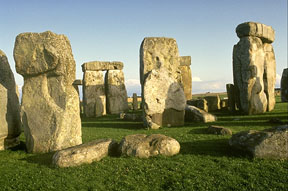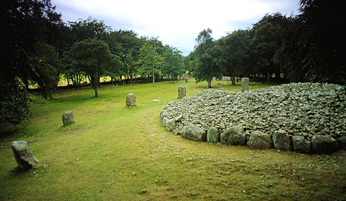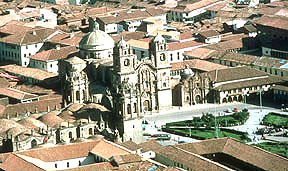You can see in this picture the standing stones arranged in straight lines and in circles. These stones mark a burial ground for the ancient Vestini tribe.
Click on image for full size
Photo courtesy Diego Meozzi/Stone Pages
The Stones of Fossa
The stone structures of
England and
France are very famous.
In Italy, you'll also find standing stones, stone rings, and stone tombs. An example of these
stone structures is in Fossa, Abruzzo, in Italy. At the Fossa site, you'll find Menhir or upright stones. The stones are arranged in circles and straight lines. They are also arranged in terms of height, from largest to smallest, so that the line of stones looks like a descending staircase.
These stones were likely put into place by the ancient Vestini tribe somewhere between 1,000 - 800 B.C.
Archeologists have found human bones at this site leading them to think it was used as a burial ground for the Vestini tribe. The stone slabs that are set in straight lines are aligned East to West. Some think that this alignment might have been both astronomical and religious. These ancient people would have seen the Sun cycle over and over again, with the Sun rising in the East and setting in the West. If these people believed in a sort of after life or reincarnation they would have hoped for a similar cycling of human soul as they buried people here. And so we see that these people might have related their culture and religion to the movements of the Sun in the sky.
Besides human bones, archeologists also found pottery, bronze vases, and weapons. These artifacts were probably buried with the original owners upon their death.
You might also be interested in:

There are over 900 rings of stone located in the British Isles. The most famous of these stone rings is of course, Stonehenge. Stonehenge lies in Wiltshire, England. Stonehenge is so mysterious that it
...more
The stones of Carnac, France, are probably the most famous stones markings outside of those found at Stonehenge in England. There are many, many stones at Carnac. And these stones are very old too, the
...more
Many people are interested in the mysterious megalithic structures that can be found around the world. A megalithic structure is a ancient monument made of large stones. Megalith comes from Greek; "mega"
...more
Not too far from Loch Ness, there lies three giant tombs made of stones. They are called the Balnuaran of Clava. The Balnuaran of Clava, giant tombs encased in stone, can be found close to Inverness in
...more
People from Asia crossed the Bering Strait into North America. These people were first in this new land and so they are known as Native Americans. Over time, these people broke into tribes (as seen on
...more
"The movements of the heavenly bodies are an admirable thing, well known and manifest to all peoples. There are no people, no matter how barbaric and primitive, that do not raise up their eyes, take note,
...more
Cuzco is located in Southern Peru. It is the ancient capital of the Inca Empire. It is the oldest, continuously occupied city in the Americas. In ancient times, Cuzco was the ceremonial capital and hub
...more















